CHEVROLET BLAZER 1997 2.G Owners Manual
Manufacturer: CHEVROLET, Model Year: 1997, Model line: BLAZER, Model: CHEVROLET BLAZER 1997 2.GPages: 402, PDF Size: 21.93 MB
Page 181 of 402
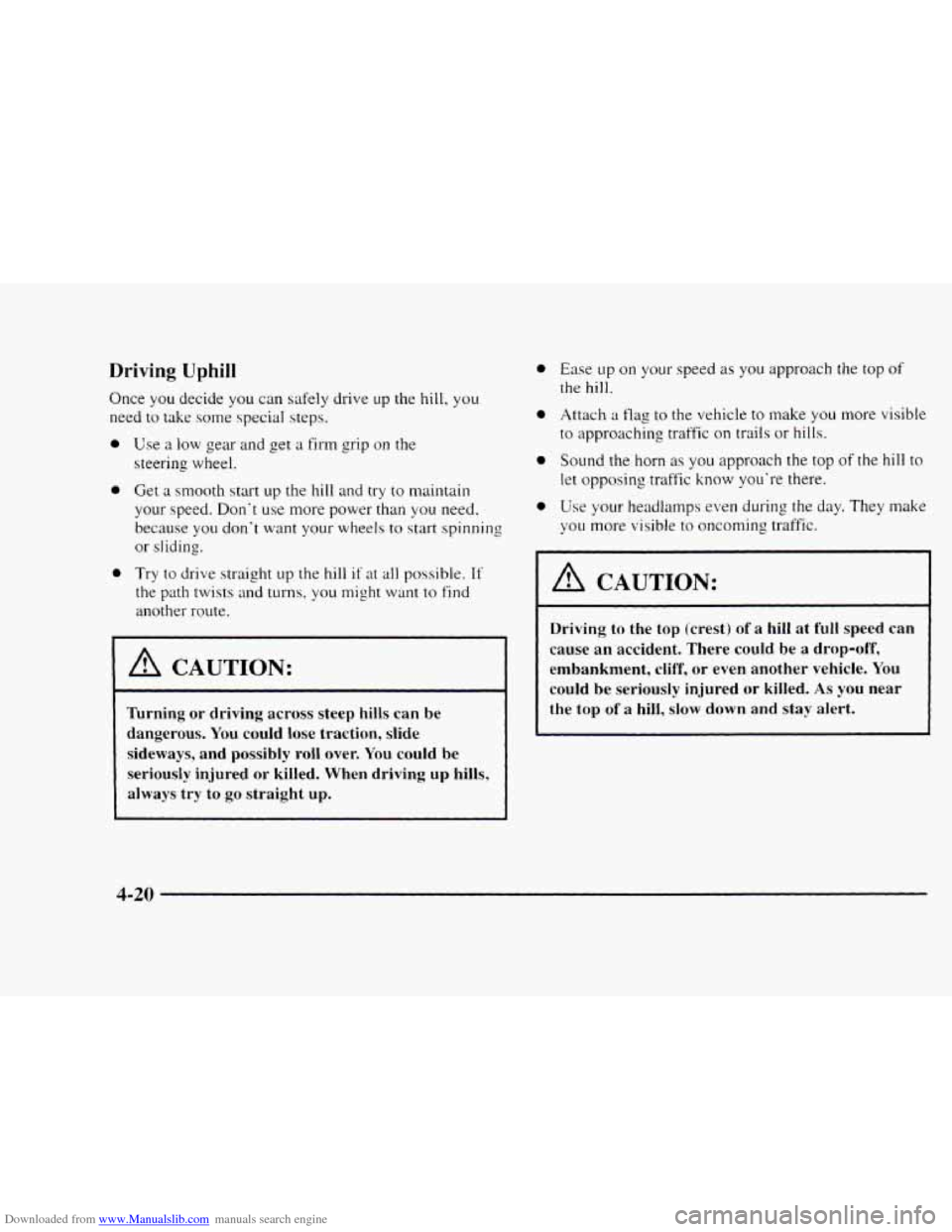
Downloaded from www.Manualslib.com manuals search engine 0
0
Driving Uphill
Once you decide you can safely drive up the hill, you
need to take some special steps.
Use
a low gear and get a firm grip or1 the
steering wheel.
Get
a smooth start up the hill and try to maintain
your speed. Don't use more power than you need.
because
you don't want your wheels to start spinning
or sliding.
Try to drive straight up the
hill if at all possible. If
the path twists and turns, you might want to find
another route.
0
I A CAUTION:
Turning or driving across steep hills can be
dangerous. You could lose traction, slide
sideways, and
possibly roll over. You could be
seriously injured or killed. When driving up hills,
always try
to go straight up.
0
0
0
0
Ease LIP on your speed as you approach the top of
the hill.
Attach a flag to the vehicle to make you more visible
to approaching traffic on trails or hills.
Sound the horn as you approach the top of the hill to
let opposing traffic know you.1-e there.
Use your headlamps even during the day. They make
you more 1:isible to oncoming traffic.
A CAUTION:
Driving to the top (crest) of a hill at full speed can
cause an accident. There could be
a drop-off,
embankment, cliff, or even another vehicle. You
could
be seriously injured or killed. As you near
the top of
a hill, slow down and stay alert.
4-20
Page 182 of 402
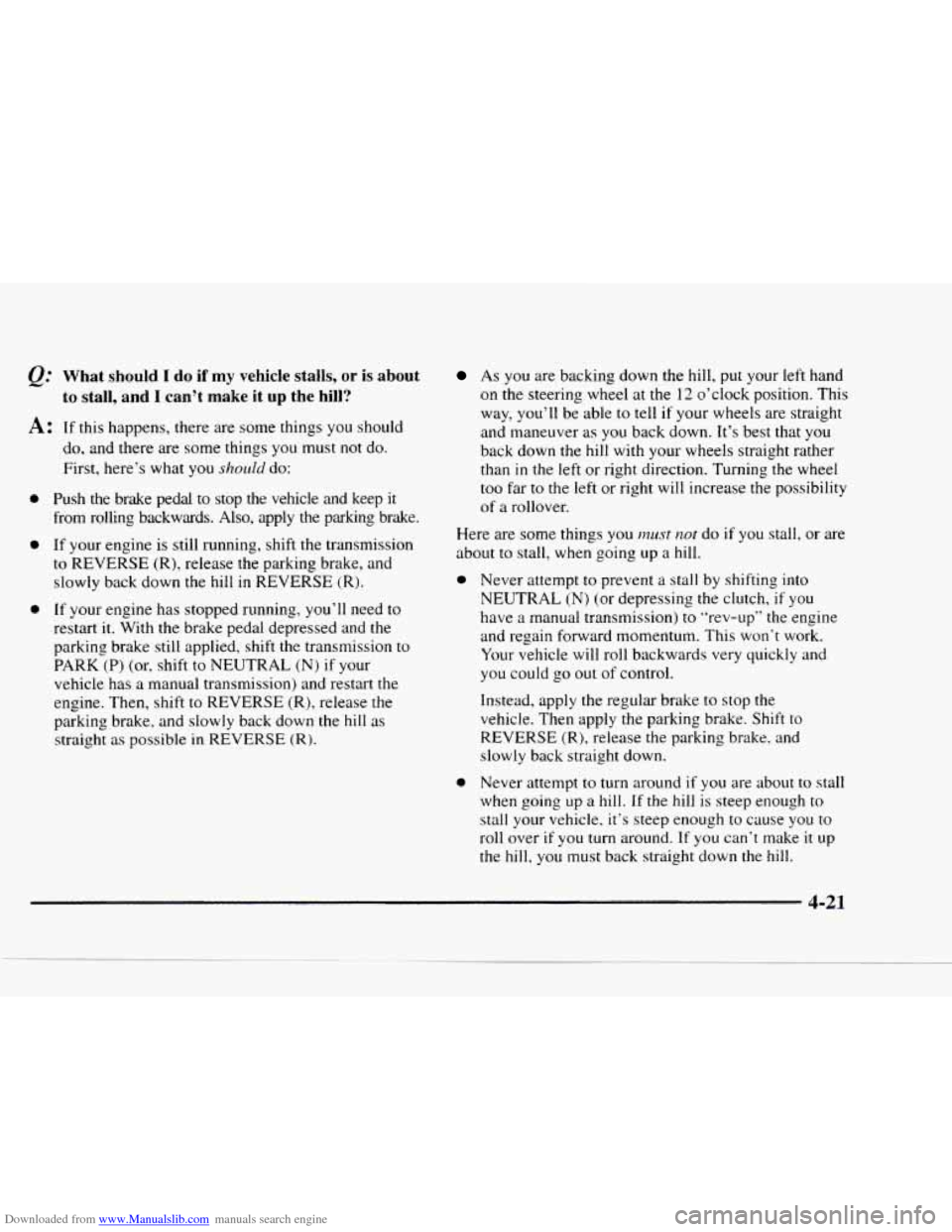
Downloaded from www.Manualslib.com manuals search engine @ What should I do if my vehicle stalls, or is about
A: If this happens, there are some things you should
to stall, and I can’t make it up the hill?
do. and there are some things you must not do.
First, here’s what
you should do:
0 Push the brake pedal to stop the vehicle and keep it
from rolling backwards. Also, apply the parking brake.
0 If your engine is still running, shift the transmission
to REVERSE
(R), release the parking brake, and
slowly back down the hill
in REVERSE (R).
0 If your engine has stopped running, you’ll need to
restart it. With the brake pedal depressed and the
parking brake still applied, shift
the transmission to
PARK (P) (or, shift to NEUTRAL (N) if your
vehicle has a manual transmission) and restart
the
engine. Then, shift to REVERSE (R), release the
parking brake, and slowly back down the
hill as
straight as possible in REVERSE (R).
As you are backing down the hill, put your left hand
on the steering wheel at the 12 o’clock position. This
way, you’ll be able
to tell if your wheels are straight
and maneuver
as you back down. It’s best that you
back down the hill with your wheels straight rather
than
in the left or right direction. Turning the wheel
too far to the left or right will increase the possibility
of
a rollover.
Here are some things
you must not do if you stall, or are
about
to stall, when going up a hill.
0 Never attempt to prevent a stall by shifting into
NEUTRAL
(N) (or depressing the clutch, if you
have
a manual transmission) to “rev-up” the engine
and regain forward momentum. This
won’t work.
Your vehicle will roll backwards very quickly and
you could go out of control.
Instead, apply the regular brake
to stop the
vehicle. Then apply
the parking brake. Shift to
REVERSE
(R), release the parking brake, and
slowly back straight down.
0 Never attempt to turn around if you are about to stall
when going up
a hill. If the hill is steep enough to
stall your vehicle, it’s steep enough to cause you to
roll over if you turn around. If you can’t make it up
the hill, you must back straight down the hill.
4-21
Page 183 of 402
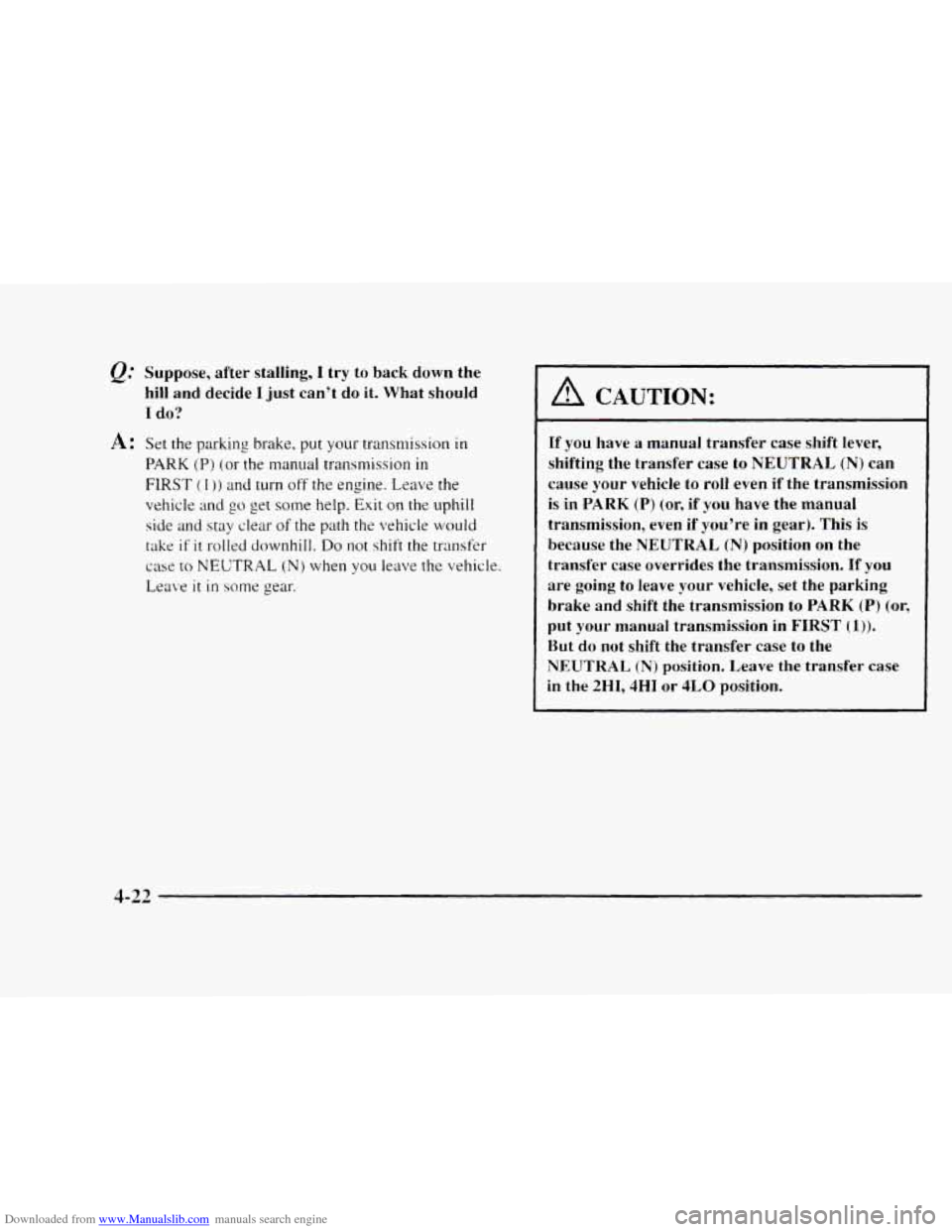
Downloaded from www.Manualslib.com manuals search engine Suppose, after stalling, I try to back down the
hill and decide
I just can’t do it. What should
I do?
A: Set the parking brake, put your transmission in
PARK (P) (or the manual transmission in
FIRST ( I )) and turn off the engine. Leave the
vehicle
and go get some help. Exit on the uphill
side and
stay clear of the path the vehicle would
take
if it rolled downhill. Do not shift the transfer
case
to NEUTRAL (N) when you leave the vehicle.
Leave
it in some gear-.
~ A CAUTION:
I
If you have a manual transfer case shift lever,
shifting the transfer case to NEUTRAL
(Nj can
cause
your vehicle to roll even if the transmission
is in
PARK (P) (or, if you have the manual
transmission, even
if you’re in gear). This is
because the NEUTRAL
(N) position on the
transfer case overrides the transmission.
If you
are going
to leave your vehicle, set the parking
brake and shift the transmission to
PARK (P) (or,
put your manual transmission in
FIRST (I)).
But do not shift the transfer case to the
NEUTRAL (N) position. Leave the transfer case
in the 2HI,4HI or 4LO position.
4-22
Page 184 of 402
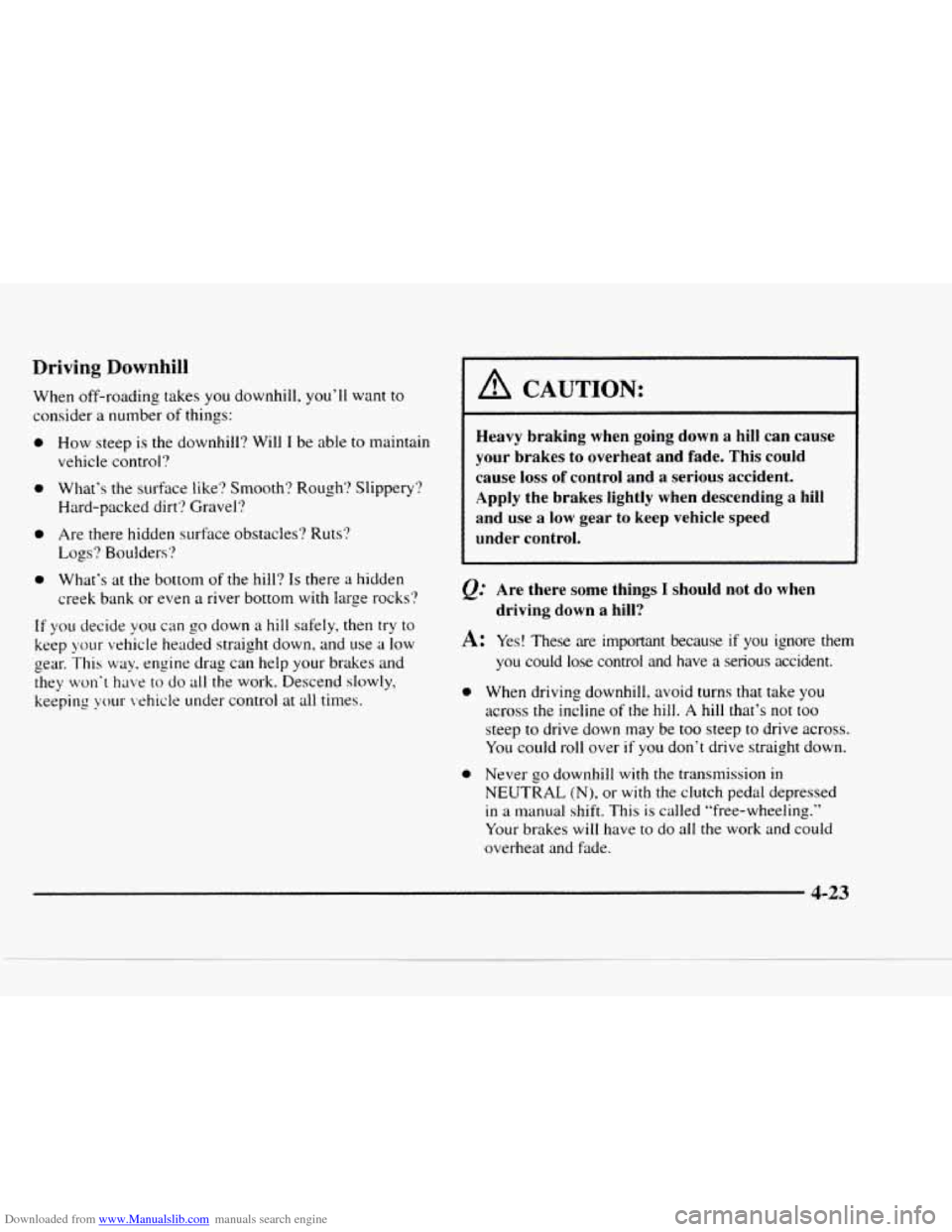
Downloaded from www.Manualslib.com manuals search engine Driving Downhill
When off-roading takes you downhill, you’ll want to
consider a number of things:
0 How steep is the downhill? Will I be able to maintain
vehicle control?
0 What’s the surface like? Smooth? Rough‘? Slippery‘?
Hard-pac ked dirt
‘? Gravel?
0 Are there hidden surface obstacles? Ruts’?
Logs? Boulders’?
0 What’s at the bottom of the hill? Is there a hidden
creek bank or even
a river bottom with large rocks?
If you decide you can go down a hill safely, then try to
keep your vehicle headed straight down, and use a low
gear. This
way. engine drag can help your brakes and
they
won‘t have to do all the work. Descend slowly,
keeping
y)ur
ehick under control at all times.
I A CAUTION:
1 I
Heavy braking when going aown a hill can cause
your brakes
to overheat and fade. This could
cause
loss of control and a serious accident.
Apply the brakes lightly when descending a hill
and use
a low gear to keep vehicle speed
under control.
&= Are there some things I should not do when
driving down a
hill?
A: Yes! These are important because if you ignore them
you could lose control and have a serious accident.
0 When driving downhill, avoid turns that take you
across the incline of the hill. A hill that’s not too
steep
to drive down may be too steep to drive across.
You could roll over if you don’t drive straight down.
NEUTRAL (N). or with the clutch pedal depressed
in a manual shift. This is called “free-wheeling.”
Your brakes will have
to do all the work and could
overheat and fade.
0 Never go downhill with the transmission in
4-23
Page 185 of 402
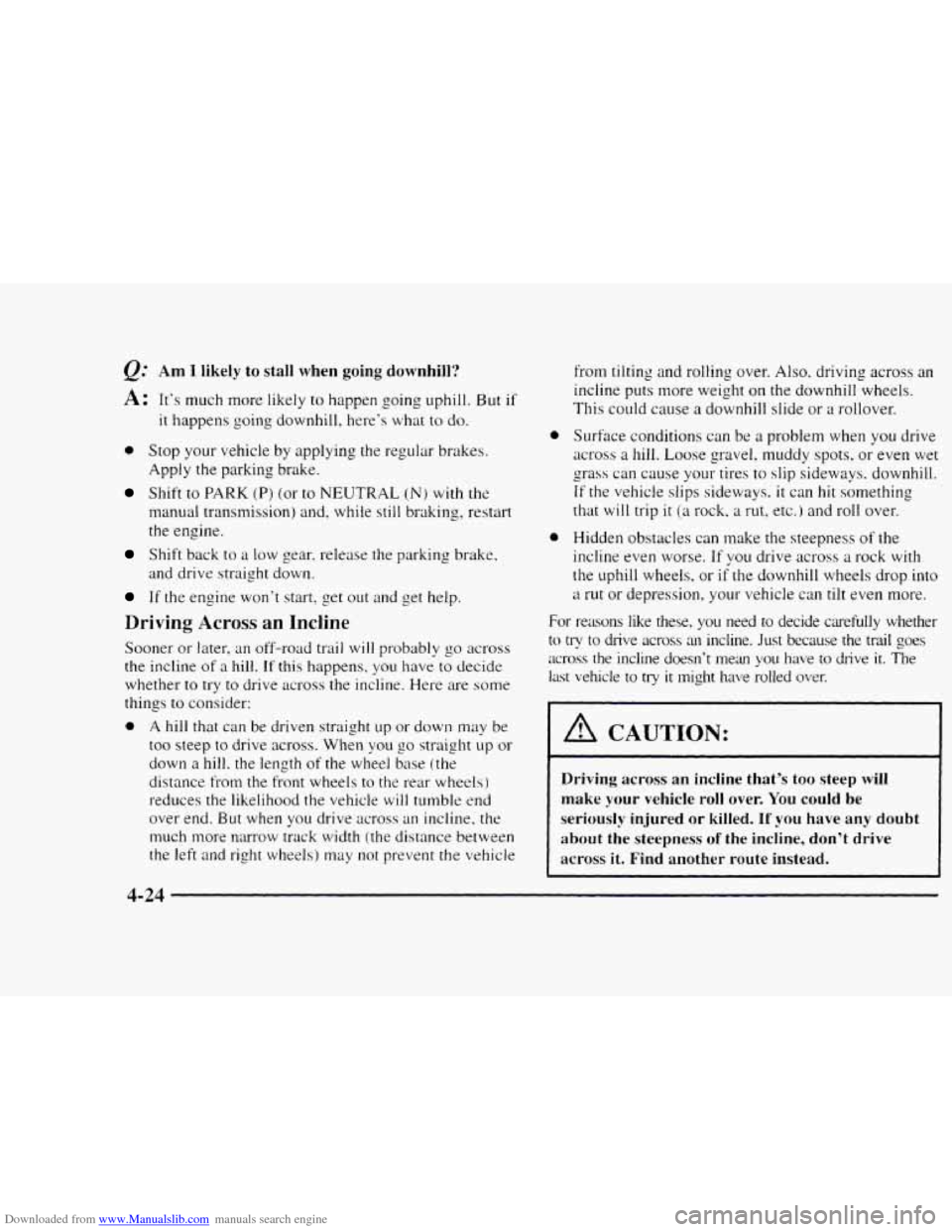
Downloaded from www.Manualslib.com manuals search engine Q: Am I likely to stall when going downhill?
A: It’s much more likely to happen going uphill. But if
it happens going downhill, here’s what to do.
0 Stop your vehicle by applying the regular brakes.
Shift to PARK (P) (or to NEUTRAL (N) with the
Apply the parking brake.
nlanual
transmission) and, while still brakin,,
0 restart
the engine.
and drive straight down.
Shift back to a low gear. release the parking brake,
If the engine won’t start, get out and get help.
Driving Across an Incline
Sooner or later, an off-road trail will probably go across
the incline of a hill. If this happens, you have to decide
whether
to try to drive across the incline. Here are some
things
to consider:
0 A hill that can be driven straight up or down may be
too steep to drive across. When you
go straight up or
down
a hill. the length of the wheel base (the
distance from the front wheels
to the rear wheels)
reduces the likelihood
the vehicle will tumble end
over end.
But when you drive across an incline, the
much more narrow track width (the distance between
the left and
right wheels) may not prevent the vehicle
0
0
from tilting and rolling over. Also, driving across an
incline puts more weight
on the downhill wheels.
This could cause
a downhill slide or a rollover.
Surface conditions can be
a problem when you drive
across
a hill. Loose gravel. muddy spots, or even wet
If the vehicle slips sideways. it can hit something
that
will trip it (a rock. a rut, etc.) and roIl over.
Hidden obstacles can make the steepness
of the
incline even worse. If you drive across a rock with
the uphill wheels, or if the downhill wheels drop into
a rut or depression, your vehicle can tilt even more.
2 orass can cause your tires to slip sideways. downhill.
For reasons like these, you need
to decide carefully whether
to try to drive across 31 incline. Just because the trail goes
;lcross the incline doesn’t mean you have to drive it. The
last vehcle
to try it might have rolled over.
A CAUTION:
Driving across an incline that’s too steep will
make your vehicle roll over. You could be
seriously injured or killed.
If you have any doubt
about the steepness
of the incline, don’t drive
across it. Find another route instead.
A
4-24
Page 186 of 402
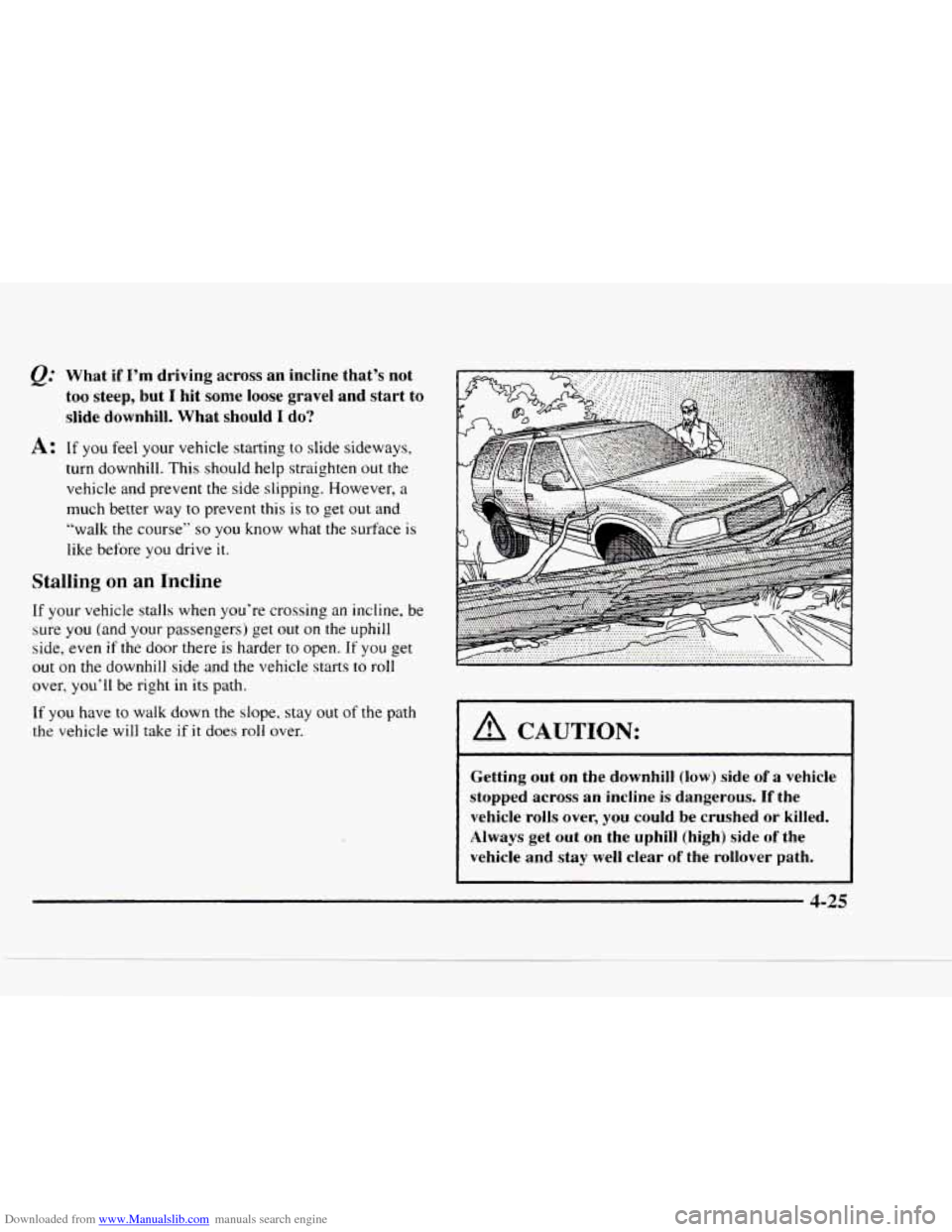
Downloaded from www.Manualslib.com manuals search engine e: What if I’m driving across an incline that’s not
too steep, but
I hit some loose gravel and start to
slide downhill. What should
I do?
A: If you feel your vehicle starting to slide side.ways,
turn downhill. This should help straighten out the
vehicle and prevent the side slipping. However,
a
much better way to prevent this is to get out and
“walk the course”
so you know what the surface is
like before you drive it.
Stalling on an Incline
If your vehicle stalls when you’re crossing an incline, be
sure
you (and your passengers) get out on the uphill
side, even
if the door there is harder to open. If you get
out on the downhill side and the vehicle starts to roll
over, you’ll be right in its path.
If you have
to walk down the slope, stay out of the path
the vehicle will take if it does roll over. A CAUTION:
Getting out on the downhill (low) side of a vehicle
stopped across an incline is dangerous.
If the
vehicle rolls over,
you could be crushed or killed.
Always get out
on the uphill (high) side of the
vehicle and stay well clear
of the rollover path.
..
4-25
Page 187 of 402
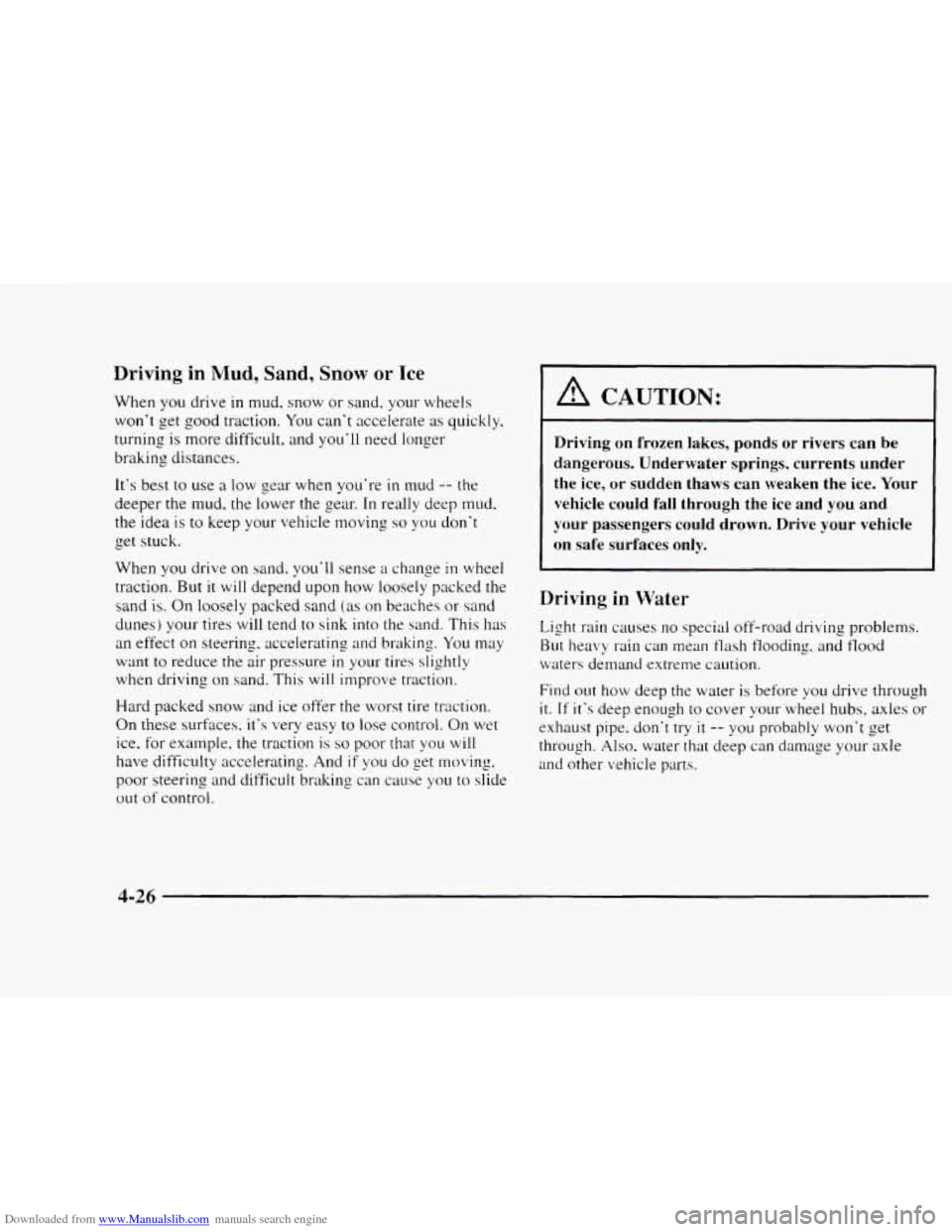
Downloaded from www.Manualslib.com manuals search engine Driving in Mud, Sand, Snow or Ice
When you drive in mud. snow or sand. your wheels
won't get good traction. You can't accelerate as quickly,
turning is more difficult. and you'll need longer
braking distances.
It's best
to use a low gear when you're in mud -- the
deeper the mud. the lower the gear.
In really deep mud.
the idea is
to keep your vehicle moving so you don't
b *et stuck.
When you drive on sand,
you'll sense a change in wheel
traction. But
it will depend upon how loosely packed the
sand is.
On loosely packed sand (as on beaches or sand
dunes) your tires will tend to
sink into the sand. This has
an effect on steering. accelerating and braking.
You may
want to reduce the air pressure in your tires slightly
when driving on sand. This
will improve traction.
Hard packed
snow and ice offer the worst tire traction.
On these surfaces,
it's very easy to lose control. On wet
ice,
for example. the traction is so poor that you will
have difficulty accelerating. And if you do get moving,
poor steering and difficult braking can
came you to slide
out
of control.
I A CAUTION:
Driving on frozen lakes, ponds or rivers can be
dangerous. Underwater springs. currents under
the ice, or sudden thaws can weaken the ice. Your
vehicle could fall through the
ice and you and
your passengers could drown. Drive your vehicle
on safe surfaces only.
Driving in Water
Light rain causes no special off-road driving problems.
But heavy rain can mean tlash flooding, and flood
waters demand extreme caution.
Find out
how deep the water is before you drive through
it. If it's deep enough to cover your wheel hubs, axles or
exhaust pipe. don't
try it -- you probably won't get
through. Also. water that deep can damage your axle
and other vehicle parts.
4-26
Page 188 of 402
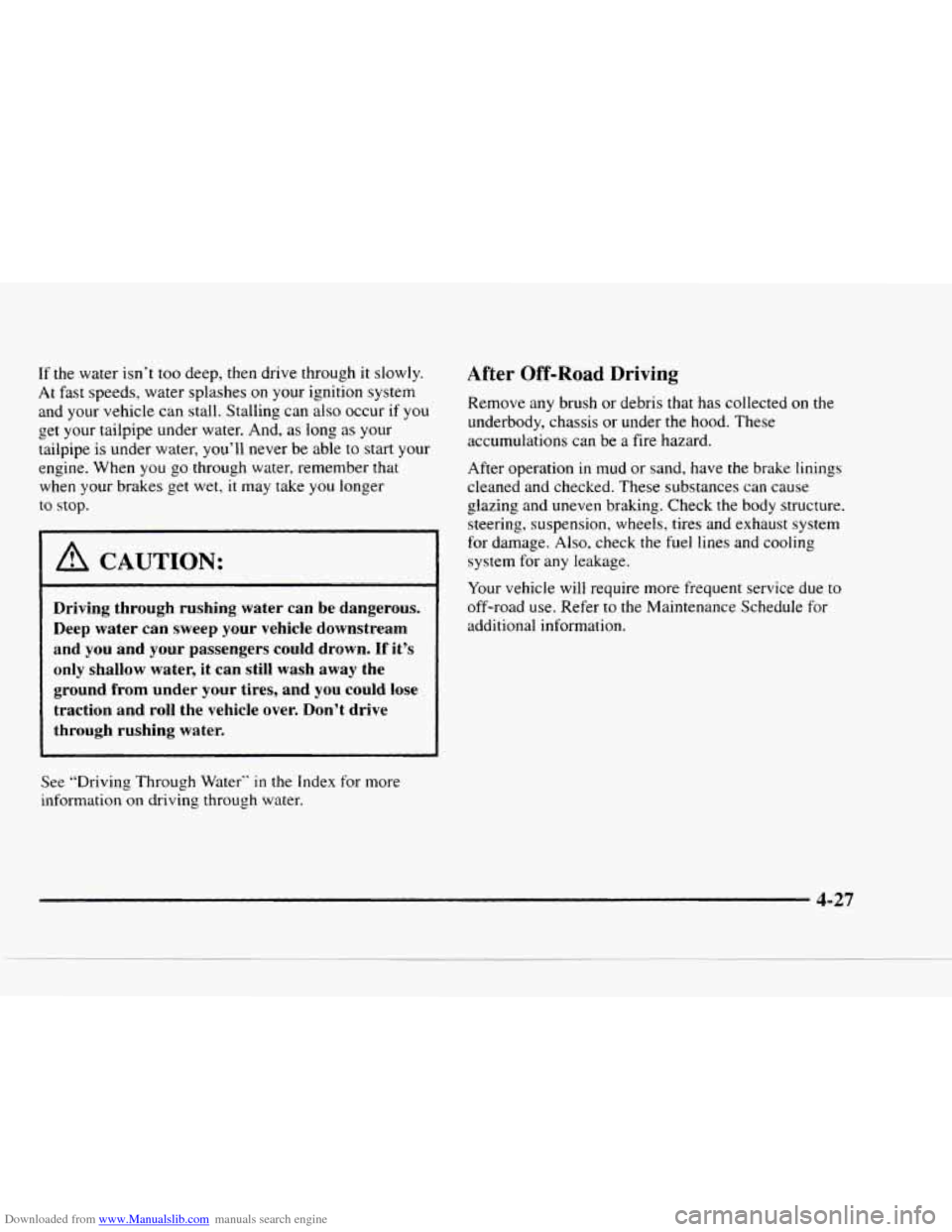
Downloaded from www.Manualslib.com manuals search engine If the water isn’t too deep, then drive through it slowly.
At fast speeds, water splashes
on your ignition system
and your vehicle can stall. Stalling can also occur if you
b get your tailpipe under water. And, as long as your
tailpipe is under water, you’ll never be able
to start your
engine. When
you go through water, remember that
when your brakes get wet, it may take you longer
to stop.
I A CAUTION:
Driving through rushing water can be dangerous.
Deep water can sweep your vehicle downstream
and you and your passengers could drown.
If it’s
only shallow water, it can still wash away the
ground from under your tires, and you could lose
traction and roll the vehicle over. Don’t drive
through rushing water.
See “Driving Through Water” in the Index for more
information on driving throwh water.
After Off-Road Driving
Remove any brush or debris that has collected on the
underbody, chassis or under the hood. These
accumulations can be
a fire hazard.
After operation in mud or sand, have
the brake linings
cleaned and checked. These substances can cause
glazing and uneven braking. Check the body structure.
steering, suspension, wheels, tires and exhaust system
for damage. Also, check the fuel lines and cooling
system for any leakage.
Your vehicle will require more frequent service due
to
off-road use. Refer to the Maintenance Schedule for
additional information.
Page 189 of 402
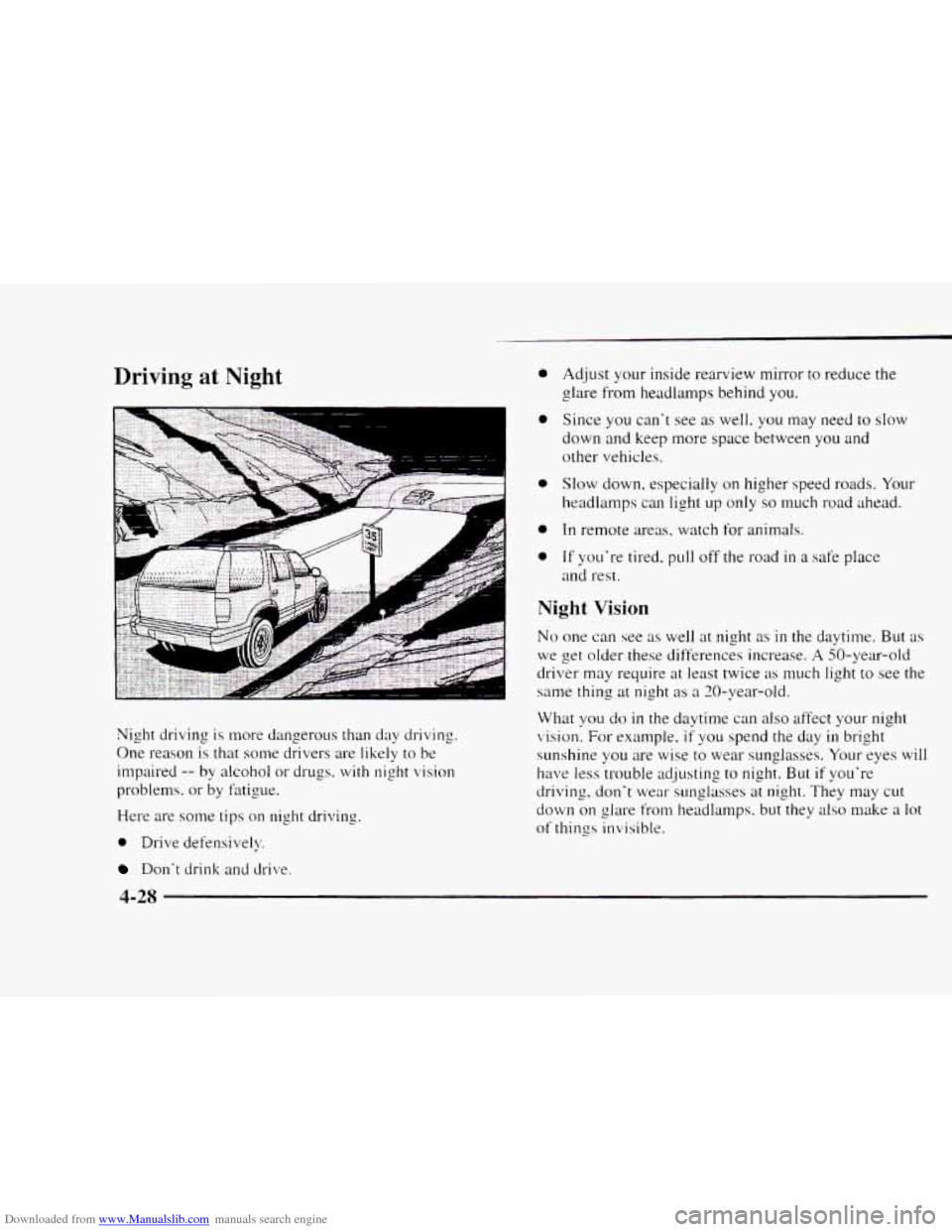
Downloaded from www.Manualslib.com manuals search engine Driving at Night a
0
0
a
0
Adjust your inside rearview mirror to reduce the
3 olare from headlamps behind you.
Since you can't see
as well, you may need to sIow
down and keep more space between you and
other vehicles.
Slow down, especially on higher speed roads. Your
headlamps
can light up only so much road ahead.
In remote areas, watch for animals.
If you're tired, pull off the road in a safe place
and rest.
k- ---I
Night Vision
No one can see as well at night as in the daytime. But as
we get older these differences increase. A 50-year-old
driver may require at least twice
as much light to see the
same thing at
night as a 20-year-old.
Night driving is more dangerous than
day driving.
One reason is that some drivers are likely to
be
impaired -- by alcohol or drugs. with night vision
problems. or by htigue.
Here are some tips on
night driving.
0 Drive defensively. What
you do
in the daytime can also affect your night
vision. For example. if you spend the day in bright
sunshine you are wise to wear sunglasses. Your eyes
will
have less trouble adjusting to night. But if you're
driving, don't wear sunglasses at night. They
may cut
down on glare from headlamps, but they also make
a lot
of things invisible.
Don't drink and drive
4-28
Page 190 of 402
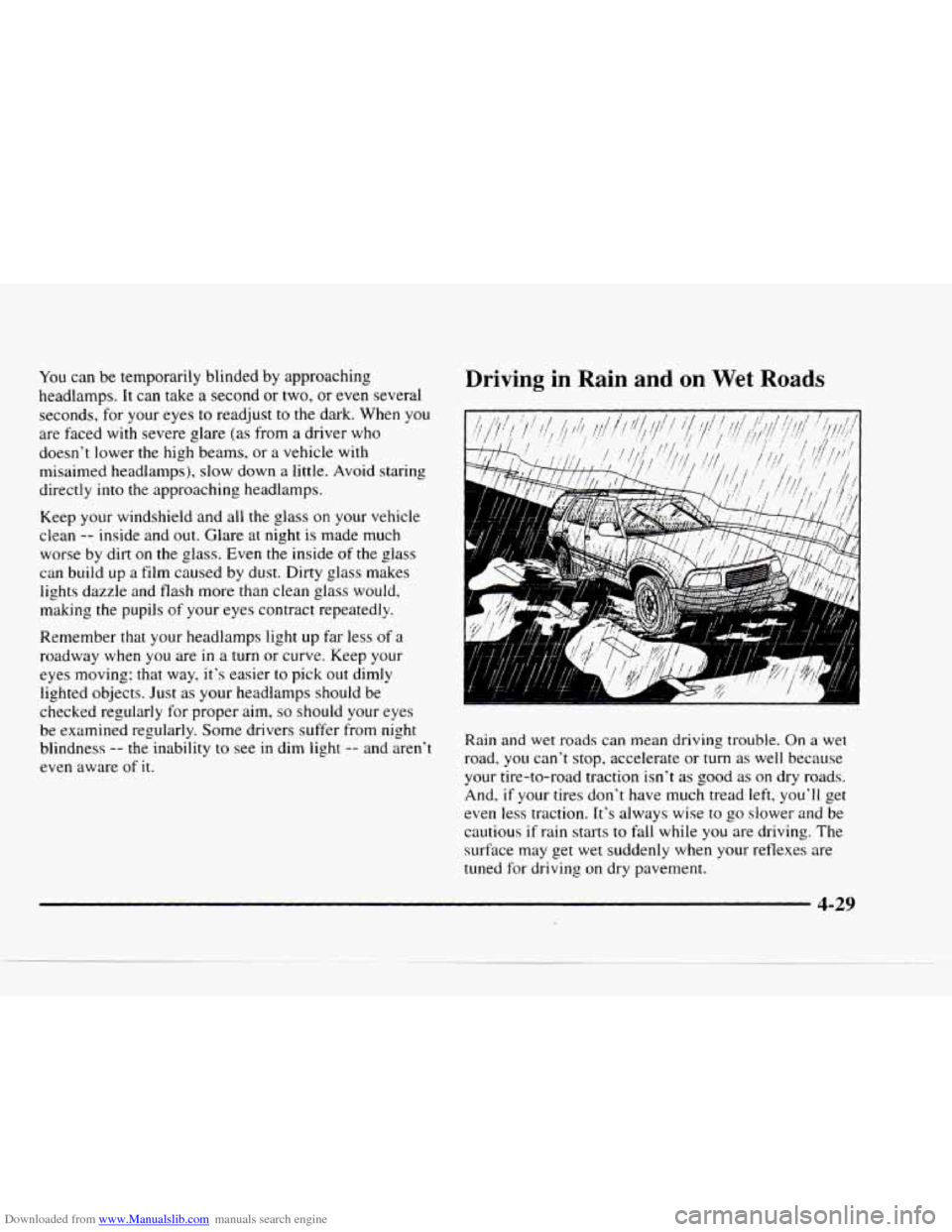
Downloaded from www.Manualslib.com manuals search engine You can be temporarily blinded by approaching
headlamps. It can take a second or two, or even several
seconds, for your eyes
to readjust to the dark. When you
are faced with severe glare
(as from a driver who
doesn’t lower the high beams, or a vehicle with
misaimed headlamps), slow down
a little. Avoid staring
directly
into the approaching headlamps.
Keep your windshield and all the glass
on your vehicle
clean
-- inside and out. Glare at night is made much
worse by dirt on
the glass. Even the inside of the glass
can build up
a film caused by dust. Dirty glass makes
lights dazzle and flash more than clean glass would,
making the pupils
of your eyes contract repeatedly.
Remember that your headlamps light
up far less of a
roadway when you are in a turn or curve. Keep your
eyes moving: that way, it’s easier
to pick out dimly
lighted objects. Just as your headlamps should be
checked regularly for proper aim,
so should your eyes
be examined regularly. Some drivers suffer from night
blindness
-- the inability to see in dim light -- and aren‘t
even aware
of it.
Driving in Rain and on Wet Roads
U
Rain and wet roads can mean driving trouble. On a wet
road, you can’t stop, accelerate or turn as well because
your tire-to-road traction isn’t as good as
on dry roads.
And,
if your tires don’t have much tread left, you’ll get
even less traction.
It’s always wise to go slower and be
cautious if rain starts to fall while you are driving. The
surface may get wet suddenly when your reflexes are
tuned for driving on dry pavement.
4-29